The Scientist and Engineer's Guide to
Digital Signal Processing
By Steven W. Smith, Ph.D.
Book Search
Table of contents
- 1: The Breadth and Depth of DSP
- 2: Statistics, Probability and Noise
- 3: ADC and DAC
- 4: DSP Software
- 5: Linear Systems
- 6: Convolution
- 7: Properties of Convolution
- 8: The Discrete Fourier Transform
- 9: Applications of the DFT
- 10: Fourier Transform Properties
- 11: Fourier Transform Pairs
- 12: The Fast Fourier Transform
- 13: Continuous Signal Processing
- 14: Introduction to Digital Filters
- 15: Moving Average Filters
- 16: Windowed-Sinc Filters
- 17: Custom Filters
- 18: FFT Convolution
- 19: Recursive Filters
- 20: Chebyshev Filters
- 21: Filter Comparison
- 22: Audio Processing
- 23: Image Formation & Display
- 24: Linear Image Processing
- 25: Special Imaging Techniques
- 26: Neural Networks (and more!)
- 27: Data Compression
- 28: Digital Signal Processors
- 29: Getting Started with DSPs
- 30: Complex Numbers
- 31: The Complex Fourier Transform
- 32: The Laplace Transform
- 33: The z-Transform
- 34: Explaining Benford's Law
How to order your own hardcover copy
Wouldn't you rather have a bound book instead of 640 loose pages?Your laser printer will thank you!
Order from Amazon.com.
Chapter 10: Fourier Transform Properties
In mathematical form: if x[n] ↔ MagX[f] & PhaseX[f], then a shift in the time domain results in: x[n+s] ↔ MagX[f] & PhaseX[f] + 2πsf (where f is expressed as a fraction of the sampling rate, running between 0 and 0.5). In words, a shift of s samples in the time domain leaves the magnitude unchanged, but adds a linear term to the phase, 2πsf. Let's look at an example of how this works.
Figure 10-3 shows how the phase is affected when the time domain waveform is shifted to the left or right. The magnitude has not been included in this illustration because it isn't interesting; it is not changed by the time domain shift. In Figs. (a) through (d), the waveform is gradually shifted from having the peak centered on sample 128, to having it centered on sample 0. This sequence of graphs takes into account that the DFT views the time domain as circular; when portions of the waveform exit to the right, they reappear on the left.
The time domain waveform in Fig. 10-3 is symmetrical around a vertical axis, that is, the left and right sides are mirror images of each other. As mentioned in Chapter 7, signals with this type of symmetry are called linear phase, because the phase of their frequency spectrum is a straight line. Likewise, signals that don't have this left-right symmetry are called nonlinear phase, and have phases that are something other than a straight line. Figures (e) through (h) show the phase of the signals in (a) through (d). As described in Chapter 7, these phase signals are unwrapped, allowing them to appear without the discontinuities associated with keeping the value between π and -π.
When the time domain waveform is shifted to the right, the phase remains a straight line, but experiences a decrease in slope. When the time domain is shifted to the left, there is an increase in the slope. This is the main property you need to remember from this section; a shift in the time domain corresponds to changing the slope of the phase.
Figures (b) and (f) display a unique case where the phase is entirely zero. This occurs when the time domain signal is symmetrical around sample zero. At first glance, this symmetry may not be obvious in (b); it may appear that the signal is symmetrical around sample 256 (i.e., N/2) instead. Remember that the DFT views the time domain as circular, with sample zero inherently connected to sample N-1. Any signal that is symmetrical around sample zero will also be symmetrical around sample N/2, and vice versa. When using members of the Fourier Transform family that do not view the time domain as periodic (such as the DTFT), the symmetry must be around sample zero to produces a zero phase.
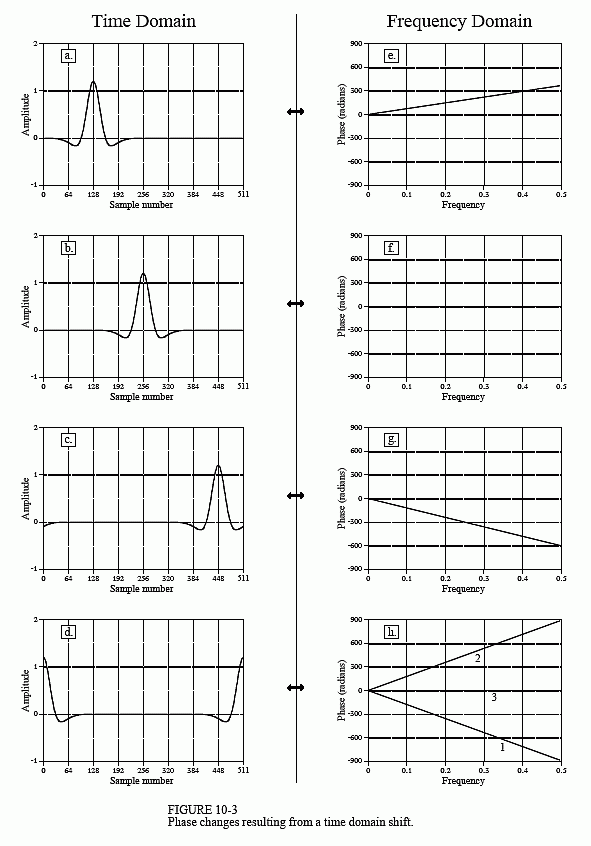
Figures (d) and (h) shows something of a riddle. First imagine that (d) was formed by shifting the waveform in (c) slightly more to the right. This means that the phase in (h) would have a slightly more negative slope than in (g). This phase is shown as line 1. Next, imagine that (d) was formed by starting with (a) and shifting it to the left. In this case, the phase should have a slightly more positive slope than (e), as is illustrated by line 2. Lastly, notice that (d) is symmetrical around sample N/2, and should therefore have a zero phase, as illustrated by line 3. Which of these three phases is correct? They all are, depending on how the π and 2π phase ambiguities (discussed in Chapter 8) are arranged. For instance, every sample in line 2 differs from the corresponding sample in line 1 by an integer multiple of 2π, making them equal. To relate line 3 to lines 1 and 2, the π ambiguities must also be taken into account.
To understand why the phase behaves as it does, imagine shifting a waveform by one sample to the right. This means that all of the sinusoids that compose the waveform must also be shifted by one sample to the right. Figure 10-4 shows two sinusoids that might be a part of the waveform. In (a), the sine wave has a very low frequency, and a one sample shift is only a small fraction of a full cycle. In (b), the sinusoid has a frequency of one-half of the sampling rate, the highest frequency that can exist in sampled data. A one sample shift at this frequency is equal to an entire 1/2 cycle, or π radians. That is, when a shift is expressed in terms of a phase change, it becomes proportional to the frequency of the sinusoid being shifted.
For example, consider a waveform that is symmetrical around sample zero, and therefore has a zero phase. Figure 10-5a shows how the phase of this signal changes when it is shifted left or right. At the highest frequency, one-half of the sampling rate, the phase increases by π for each one sample shift to the left, and decreases by π for each one sample shift to the right. At zero frequency there is no phase shift, and all of the frequencies between follow in a straight line.
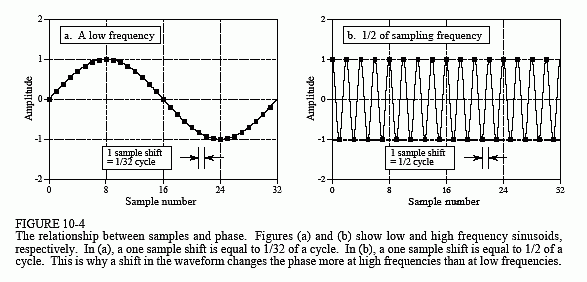
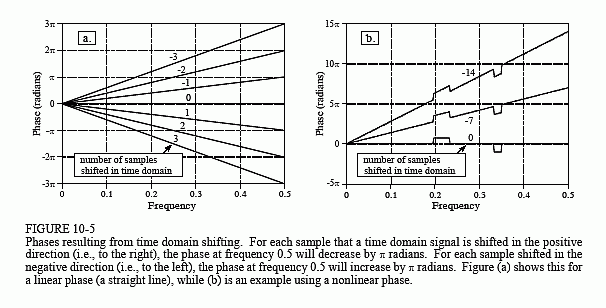
All of the examples we have used so far are linear phase. Figure 10-5b shows that nonlinear phase signals react to shifting in the same way. In this example the nonlinear phase is a straight line with two rectangular pulses. When the time domain is shifted, these nonlinear features are simply superimposed on the changing slope.
What happens in the real and imaginary parts when the time domain waveform is shifted? Recall that frequency domain signals in rectangular notation are nearly impossible for humans to understand. The real and imaginary parts typically look like random oscillations with no apparent pattern. When the time domain signal is shifted, the wiggly patterns of the real and imaginary parts become even more oscillatory and difficult to interpret. Don't waste your time trying to understand these signals, or how they are changed by time domain shifting.
Figure 10-6 is an interesting demonstration of what information is contained in the phase, and what information is contained in the magnitude. The waveform in (a) has two very distinct features: a rising edge at sample number 55, and a falling edge at sample number 110. Edges are very important when information is encoded in the shape of a waveform. An edge indicates when something happens, dividing whatever is on the left from whatever is on the right. It is time domain encoded information in its purest form. To begin the demonstration, the DFT is taken of the signal in (a), and the frequency spectrum converted into polar notation. To find the signal in (b), the phase is replaced with random numbers between -π and π, and the inverse DFT used to reconstruct the time domain waveform. In other words, (b) is based only on the information contained in the magnitude. In a similar manner, (c) is found by replacing the magnitude with small random numbers before using the inverse DFT. This makes the reconstruction of (c) based solely on the information contained in the phase.
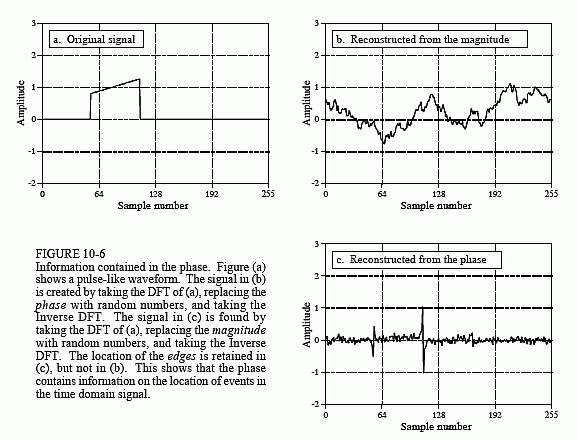
The result? The locations of the edges are clearly present in (c), but totally absent in (b). This is because an edge is formed when many sinusoids rise at the same location, possible only when their phases are coordinated. In short, much of the information about the shape of the time domain waveform is contained in the phase, rather than the magnitude. This can be contrasted with signals that have their information encoded in the frequency domain, such as audio signals. The magnitude is most important for these signals, with the phase playing only a minor role. In later chapters we will see that this type of understanding provides strategies for designing filters and other methods of processing signals. Understanding how information is represented in signals is always the first step in successful DSP.
Why does left-right symmetry correspond to a zero (or linear) phase? Figure 10-7 provides the answer. Such a signal can be decomposed into a left half and a right half, as shown in (a), (b) and (c). The sample at the center of symmetry (zero in this case) is divided equally between the left and right halves, allowing the two sides to be perfect mirror images of each other. The magnitudes of these two halves will be identical, as shown in (e) and (f), while the phases will be opposite in sign, as in (h) and (i). Two important concepts fall out of this. First, every signal that is symmetrical between the left and right will have a linear phase because the nonlinear phase of the left half exactly cancels the nonlinear phase of the right half.
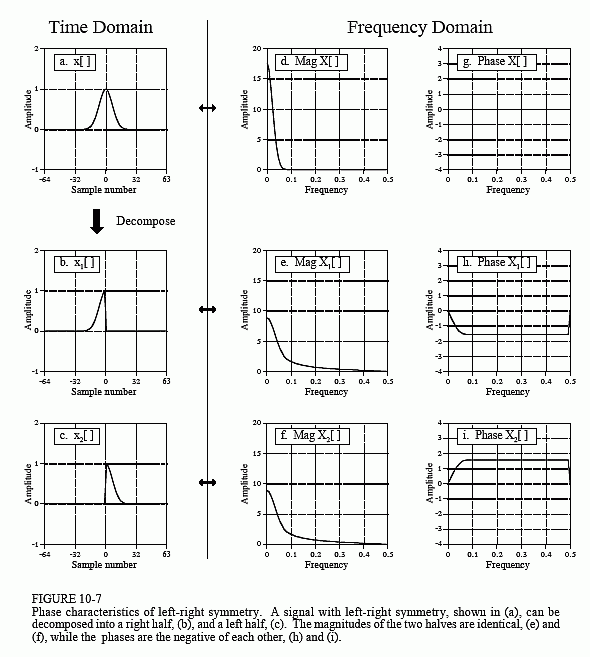
Second, imagine flipping (b) such that it becomes (c). This left-right flip in the time domain does nothing to the magnitude, but changes the sign of every point in the phase. Likewise, changing the sign of the phase flips the time domain signal left-for-right. If the signals are continuous, the flip is around zero. If the signals are discrete, the flip is around sample zero and sample N/2, simultaneously.
Changing the sign of the phase is a common enough operation that it is given its own name and symbol. The name is complex conjugation, and it is represented by placing a star to the upper-right of the variable. For example, if X[f] consists of MagX[f] and PhaseX[f], then X*[f] is called the complex conjugate and is composed of MagX[f] and -PhaseX[f]. In rectangular notation, the complex conjugate is found by leaving the real part alone, and changing the sign of the imaginary part. In mathematical terms, if X[f] is composed of ReX[f] and ImX[f], then X*[f] is made up of ReX[f] and -ImX[f].
Here are several examples of how the complex conjugate is used in DSP. If x[n] has a Fourier transform of X[f], then x[-n] has a Fourier transform of X∗[f]. In words, flipping the time domain left-for-right corresponds to changing the sign of the phase. As another example, recall from Chapter 7 that correlation can be performed as a convolution. This is done by flipping one of the signals left-for-right. In mathematical form, a[n] * b[n] is convolution, while a[n] * b[-n] is correlation. In the frequency domain these operations correspond to A[f] × B[f] and A[f] × B*[f], respectively. As the last example, consider an arbitrary signal, x[n], and its frequency spectrum, X[f]. The frequency spectrum can be changed to zero phase by multiplying it by its complex conjugate, that is, X[f] × X*[f]. In words, whatever phase X[f] happens to have will be canceled by adding its opposite (remember, when frequency spectra are multiplied, their phases are added). In the time domain, this means that x[n] * x[-n] (a signal convolved with a left-right flipped version of itself) will have left-right symmetry around sample zero, regardless of what x[n] is.
To many engineers and mathematicians, this kind of manipulation is DSP. If you want to be able to communicate with this group, get used to using their language.
